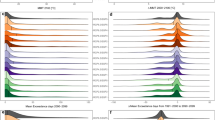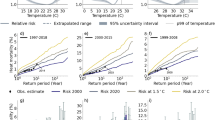Abstract
Extreme heat events are likely to become more frequent in the coming decades owing to climate change1,2. Exposure to extreme heat depends not only on changing climate, but also on changes in the size and spatial distribution of the human population. Here we provide a new projection of population exposure to extreme heat for the continental United States that takes into account both of these factors. Using projections from a suite of regional climate models driven by global climate models and forced with the SRES A2 scenario3 and a spatially explicit population projection consistent with the socioeconomic assumptions of that scenario, we project changes in exposure into the latter half of the twenty-first century. We find that US population exposure to extreme heat increases four- to sixfold over observed levels in the late twentieth century, and that changes in population are as important as changes in climate in driving this outcome. Aggregate population growth, as well as redistribution of the population across larger US regions, strongly affects outcomes whereas smaller-scale spatial patterns of population change have smaller effects. The relative importance of population and climate as drivers of exposure varies across regions of the country.
This is a preview of subscription content, access via your institution
Access options
Subscribe to this journal
Receive 12 print issues and online access
$209.00 per year
only $17.42 per issue
Buy this article
- Purchase on Springer Link
- Instant access to full article PDF
Prices may be subject to local taxes which are calculated during checkout




Similar content being viewed by others
References
Collins, M. R. et al. in Climate Change 2013: The Physical Science Basis (eds Stocker, T. F. et al.) Ch. 12 (IPCC, Cambridge Univ. Press, 2013).
Walsh, J. D. et al. Climate Change Impacts in the United States: The Third National Climate Assessment Ch. 2, 19–67 (US Global Change Research Program, 2014).
Nakicenovic, N. et al. IPCC Special Report on Emissions Scenarios (Cambridge Univ. Press, 2010).
Cardona, O. D. et al. in Managing the Risks of Extreme Events and Disasters to Advance Climate Change Adaptation (eds Field, C. B. et al.) Ch. 2 (IPCC, Cambridge Univ. Press, 2012).
IPCC Climate Change 2013: The Physical Science Basis (eds Stocker, T. F. et al.) (Cambridge Univ. Press, 2013).
Luber, G. K. et al. Climate Change Impacts in the United States: The Third National Climate Assessment Ch. 9, 220–256 (US Global Change Research Program, 2014).
van Vuuren, D. et al. A new scenario framework for Climate Change Research: Scenario matrix architecture. Climatic Change 122, 373–386 (2014).
Luber, G. & McGeehin, M. Climate change and extreme heat events. Am. J. Prev. Med. 35, 429–435 (2008).
Climate Change and Extreme Heat Events (CDC, 2012); http://www.cdc.gov/climateandhealth/pubs/ClimateChangeandExtremeHeatEvents.pdf
Duffy, P. B. & Tebaldi, C. Increasing prevalence of extreme summer temperatures in the U.S. Climatic Change 111, 487–495 (2012).
Kharin, V. V., Zwiers, F. W., Zhang, X. & Wehner, M. Changes in temperature and precipitation extremes in the CMIP5 ensemble. Climatic Change 119, 345–357 (2013).
Anderson, B. G. & Bell, M. L. Weather-related mortality: How heat, cold, and heat waves affect mortality in the United States. Epidemiology 20, 205–213 (2009).
Kovats, R. S. & Hajat, S. Heat stress and public health: A critical review. Annu. Rev. Public Health 29, 41–55 (2008).
McGeehin, M. A. & Mirabelli, M. The potential impacts of climate variability and change on temperature-related morbidity and mortality in the United States. Environ. Health Perspect. 109, 185–189 (2001).
Moss, R. P. L. et al. Climate Change Impacts in the United States: The Third National Climate Assessment Ch. 26, 620–647 (US Global Change Research Program, 2014).
Bouwer, L. M. Projections of future extreme weather losses under changes in climate and exposure. Risk Anal. 33, 915–930 (2013).
Vorhees, S. A. et al. Climate change-related temperature impacts on warm season heat mortality: A proof-of-concept methodology using BenMAP. Environ. Sci. Technol. 45, 1450–1457 (2011).
Corell, R. W. et al. Climate Change Impacts in the United States: The Third National Climate Assessment Ch. 29, 707–718 (US Global Change Research Program, 2014).
Jones, B. & O’Neill, B. C. Historically grounded spatial population projections for the continental United States. Environ. Res. Lett. 8, 044021 (2013).
Barnett, A. G., Tong, S. & Clements, A. C. A. What measure of temperature is the best predictor of mortality? Environ. Res. 110, 604–611 (2010).
Gasparrini, A. & Armstrong, B. The impact of heat waves on mortality. Epidemiology 22, 68–73 (2012).
Knowlton, K. et al. Projecting heat-related mortality impacts under a changing climate in the New York City region. Am. J. Public Health 97, 2028–2034 (2007).
Wilder, M. G. et al. in Assessment of Climate Change in the Southwest United States: A Report Prepared for the National Climate Assessment (eds Garfin, G., Jardine, A., Merideth, R., Black, M. & LeRoy, S.) 340–384 (Island Press, 2013).
Oleson, K. W., Bonan, G. B., Feddema, J. & Jackson, T. An examination of urban heat island characteristics in a global climate model. Int. J. Clim. 31, 1848–1865 (2011).
DiLuca, A. et al. Potential for added value in present temperature simulated by high-resolution nested RCMs in climate and in the climate change signal. Clim. Dynam. 40, 443–464 (2013).
Mearns, L. O. et al. Climate change projections of the North American Regional Climate Change Assessment Program (NARCCAP). Climatic Change 120, 965–975 (2013).
Mearns, L. O. et al. A regional climate change assessment program for North America. Eos 90, 311–312 (2009).
Mearns, L. O. et al. The North American Regional Climate Change Assessment Program 2014–02-06 (National Center for Atmospheric Research Earth System, accessed 6 February 2014); http://dx.doi.org/10.5065/D6RN35ST
McGinnis, S., Nychka, D. & Mearns, L. O. in Machine Learning and Data Mining Approaches to Climate Science: Proc. 4th Int. Workshop on Climate Informatics (eds Lakshmanan, V., Gilleland, E., McGovern, A. & Tingley, M.) (Springer, in the press); http://go.nature.com/IjDyt6
Maurer, E. P., Wood, A. W., Adam, J. C., Lettenmaier, D. P. & Nijssen, B. A long-term hydrologically-based data set of land surface fluxes and states for the conterminous United States. J. Clim. 15, 3237–3251 (2002).
Acknowledgements
The contributions of B.J. and B.C.O’N. to this work were supported in part by the DOE Office of Science program on Integrated Assessment of Global Climate Change, award DE-SC0006704. The contributions of L.M. and S.M. were supported in part by the National Science Foundation through the NCAR Weather and Climate Impacts Assessment Science Program. C.T. was supported by the Regional and Global Climate Modeling Program (RGCM) of the US Department of Energy’s, Office of Science (BER), Cooperative Agreement DE-FC02-97ER62402.
Author information
Authors and Affiliations
Contributions
B.J. produced the spatial population projections and the projections of exposure, contributed to methodological design, and wrote the paper. B.C.O’N. contributed significantly to methodological design and editing the paper. L.O.M. leads the NARCCAP team, of which L.M. and S.M. are members. All three provided climate model output, methodological guidance, and contributed to editing the paper. C.T. contributed to methodological design and editing the paper.
Corresponding author
Ethics declarations
Competing interests
The authors declare no competing financial interests.
Supplementary information
Rights and permissions
About this article
Cite this article
Jones, B., O’Neill, B., McDaniel, L. et al. Future population exposure to US heat extremes. Nature Clim Change 5, 652–655 (2015). https://doi.org/10.1038/nclimate2631
Received:
Accepted:
Published:
Issue Date:
DOI: https://doi.org/10.1038/nclimate2631
This article is cited by
-
Survey of extreme heat public health preparedness plans and response activities in the most populous jurisdictions in the United States
BMC Public Health (2023)
-
Historic evolution of population exposure to heatwaves in Xinjiang Uygur Autonomous Region, China
Scientific Reports (2023)
-
Impacts of climate change, population growth, and power sector decarbonization on urban building energy use
Nature Communications (2023)
-
Projected climate extremes over agro-climatic zones of Ganga River Basin under 1.5, 2, and 3° global warming levels
Environmental Monitoring and Assessment (2023)
-
Delineating and characterizing changes in heat wave events across the United States climate regions
Climatic Change (2023)



